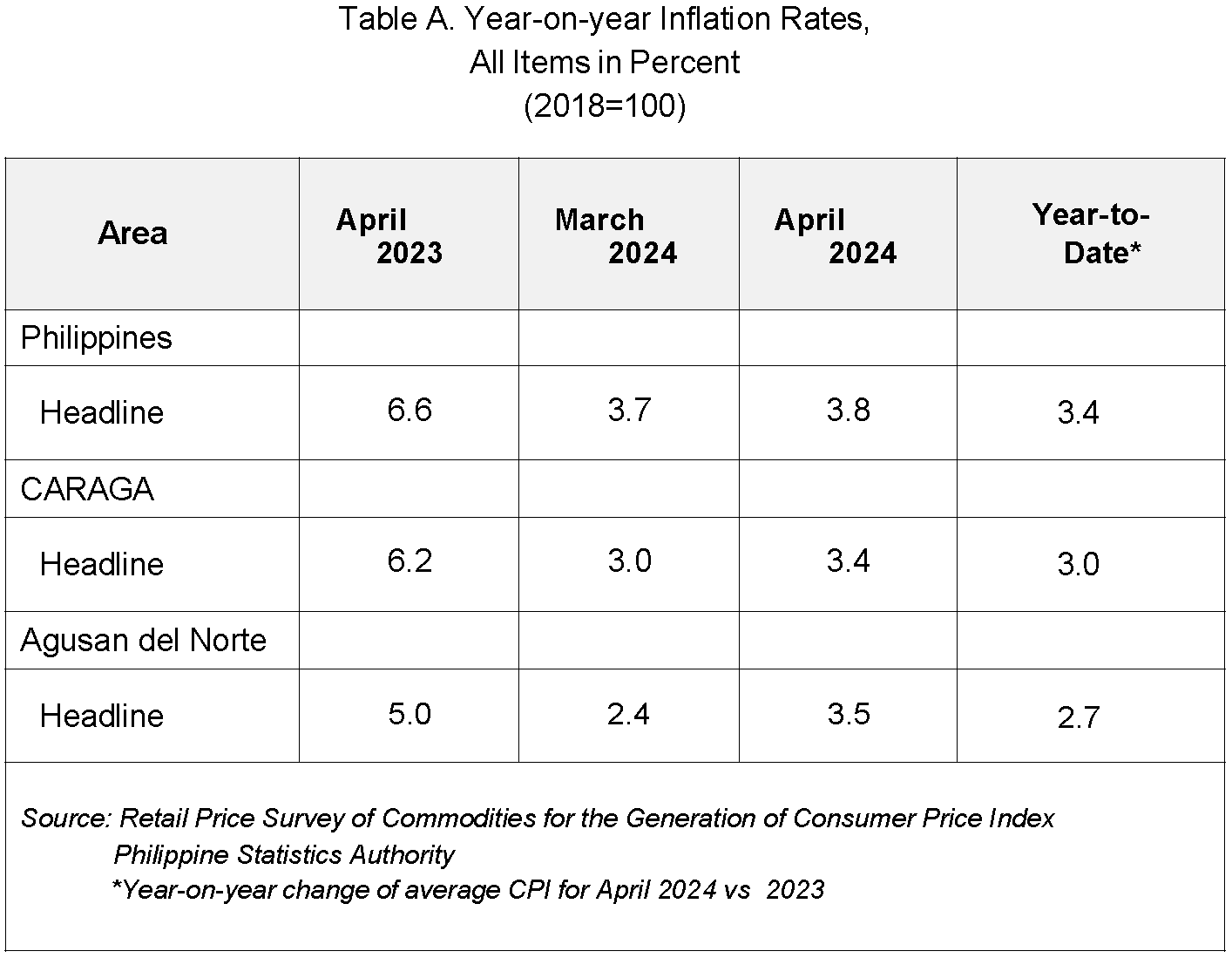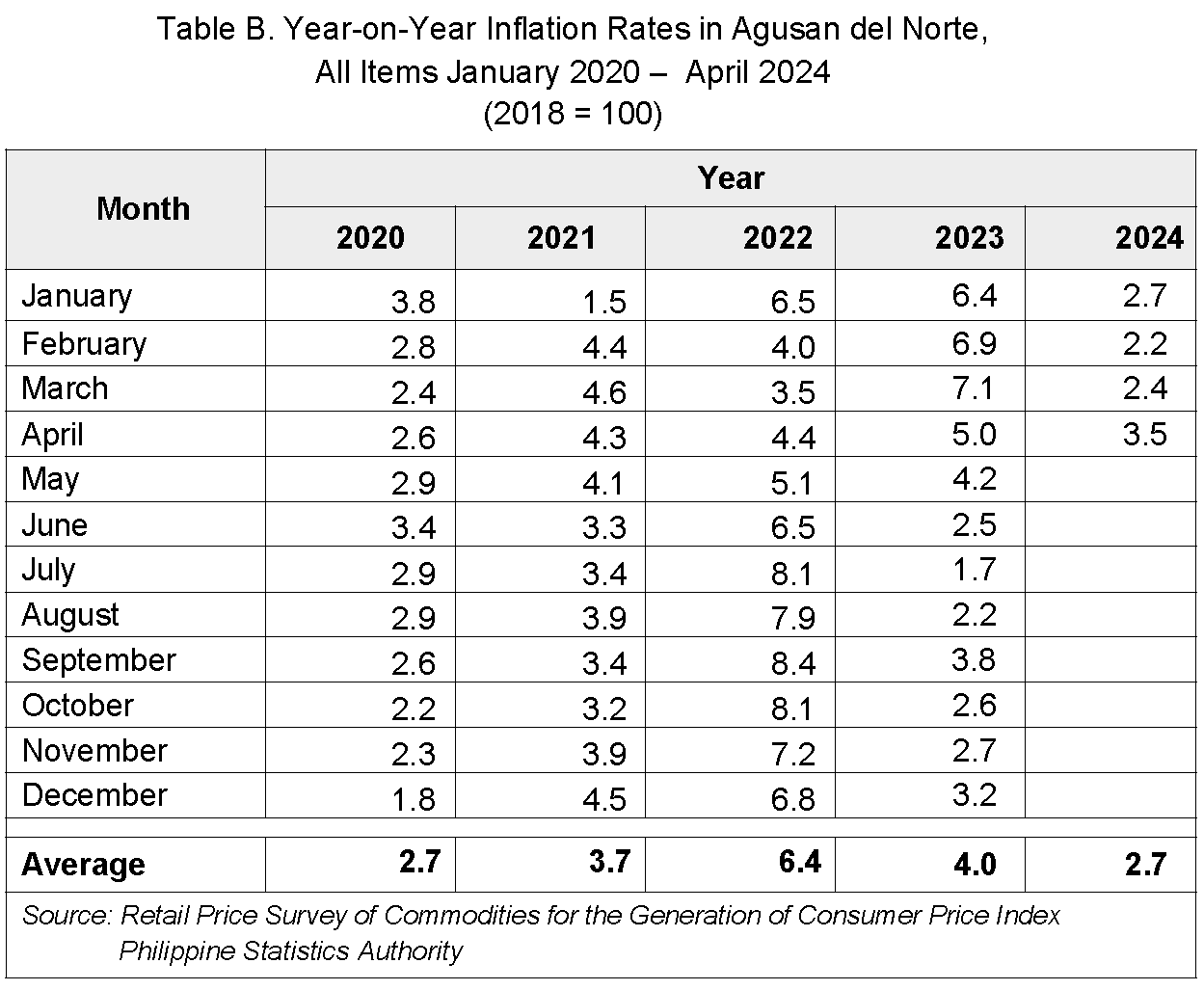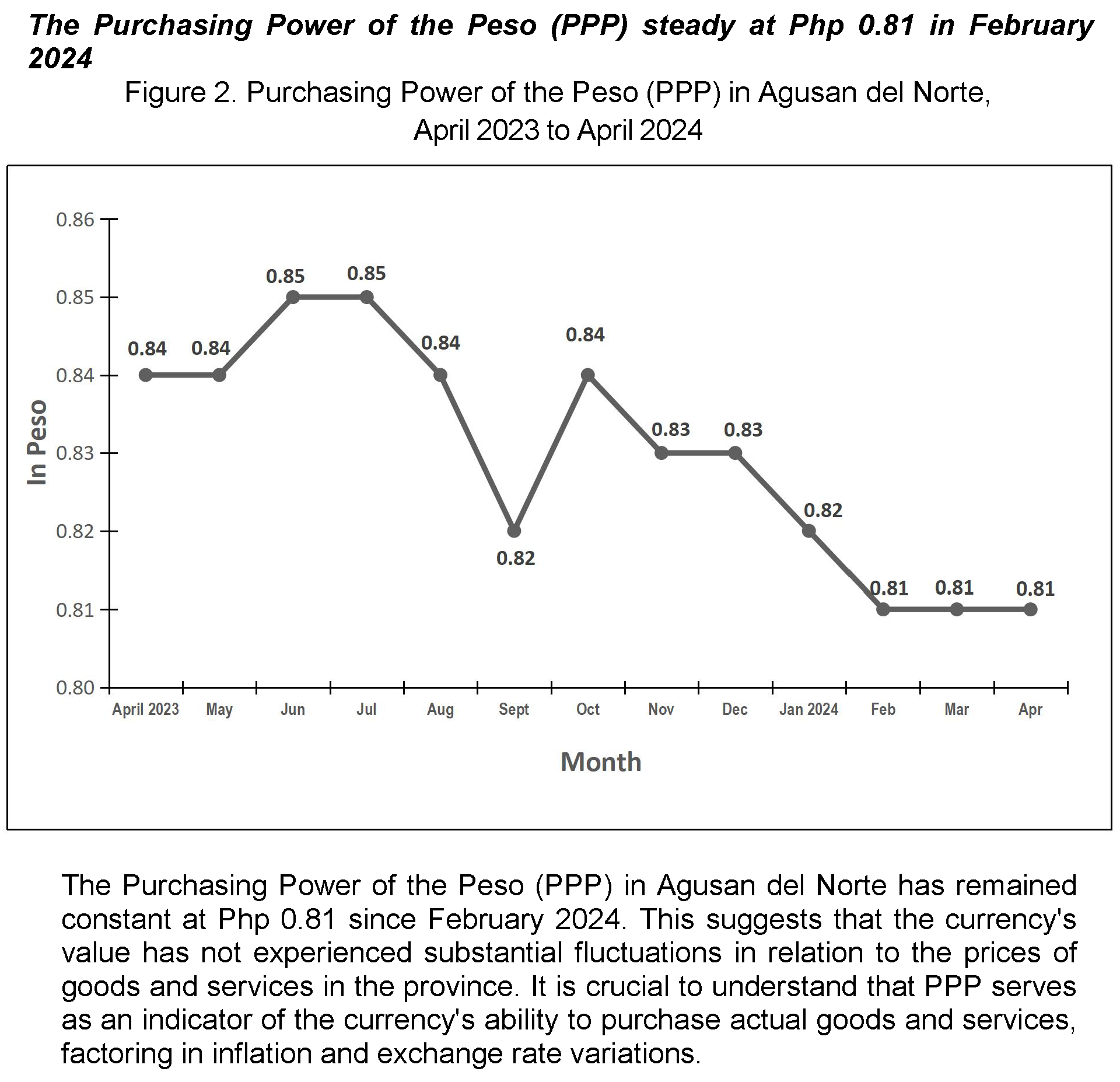Summary Inflation Report Consumer Price Index (CPI) (2018=100) Agusan del Norte April 2024

The headline inflation rate in Agusan del Norte high at 3.5% in April 2024
In April 2024, the inflation rate in Agusan del Norte province surged to 3.5 percent from its previous March 2024 inflation of 2.4 percent. This signifies an increase of 1.1 percentage points compared to the prior month's inflation rate, yet a deceleration of (1.5) percent when contrasted with April 2023's inflation rate of 5.0 percent.

Major Contributors to the April 2024 Inflation
The following groups mainly contributed to this month’s inflation. These are:
The inflation rate for Food and Non-Alcoholic Beverages surged to 7.6 percent in April 2024, marking a notable increase from the previous month's 5.5 percent. This category contributed significantly, representing 105.3 percent of the total inflation for the month.;
Personal care and miscellaneous goods and services' saw a slight decrease in inflation, dropping from 3.7 percent in March 2024 to 3.4 percent in April 2024. Despite this decline, it still holds the second position and contributes approximately 4.2 percent to the overall inflation rate for this month.
The Transportation sector experienced a 1.5 percent inflation rate this month, marking a 0.3 percentage point increase from the 1.2 percent reported in March 2024. This sector contributed approximately 4.1 percent to the province's overall inflation rate.

Major Contributor to the Year-on-Year Inflation Trend
Among the thirteen (13) commodity groups, these top three (3) groups have significantly contributed to the escalation of inflation. These are the following:
1) The Food and Non-Alcoholic Beverages category saw inflation rise from
5.5 percent in March 2024 to 7.6 percent in April 2024. This category primarily accounted for an 88.1 percent share of the inflation increase.
2) The Housing, Water, Electricity, Gas, and Other Fuels category, while still showing a negative trend, experienced a deceleration in its deflation rate from -5.2 percent last month to -4.6 percent this month. This sector accounted for approximately 8.9 percent of the inflation trend.
3) The Transport sector claimed the third position, with its inflation rate rising to 1.5 percent in April 2024 from 1.2 percent in March 2024, contributing around 2.5 percent to the total inflation rate.
Inflation Rate by Commodity Group
The following are the inflation rate by commodity groups for this month
April 2024 :
a. Food and Non-Alcoholic Beverages from 5.5 percent in March 2024 to 7.6 percent in April 2024;
b. Alcoholic Beverages and Tobacco from 4.5 percent in the previous month dropped to 2.8 percent this month;
c. Clothing and Footwear at 3.2 percent in March 2024 down to 2.4 percent in April 2024;
d. Housing, Water, Electricity, Gas and Other Fuels registered at -5.2 percent in March 2024 to -4.6 percent in April 2024;
e. Furnishings, Household Equipment and Routine Household Maintenance increase to 1.8 percent this month from 1.7 percent last month;
f. Health increased at 1.1 percent from 1.0 percent;
g. Transport increased to 1.5 percent this month from 1.2 percent last month;
h. Information and Communication remained stable at 0.3 percent from March 2024;
i. Recreation, Sport and Culture decelerate to 3.5 percent in April 2024 from 3.9 percent in March 2024;
j. The Education Services group has exhibited a steady inflation rate of 0.5 percent from March 2024.;
k. Restaurants and Accommodation Services remained stable at 1.0 percent from March 2024;
l. Financial Services also stable at 0.0 percent; and lastly
m. Personal Care, and Miscellaneous Goods and Services declined at 3.4 percent in April 2024 from 3.7 percent in March 2024.
Food Alone Inflation
In April 2024, the province experienced a surge in its food inflation rate to 8.1 percent from the previous month's 5.8 percent, indicating a rise of 2.3 percentage points. This marks a notable increase of 2.6 percentage points compared to the 5.5 percent inflation rate recorded in April 2023. The major contributors for the Food groups inflation trend are the following:
1) The main factor influencing the inflation rate in the food category is fish and other seafood. Despite experiencing deflation, this specific group saw a decrease in its deflation rate from -9.2 percent last month to -1.8 percent this month. This shift can be linked to the rise in average prices of certain fresh fish, notably Tamban. This specific food category accounted for around 65.9 percent of the overall food inflation trend.
2) Ranked second on the list is the Fruits and Nuts category, which experienced a notable surge in inflation in April 2024, reaching 2.7 percent from a previous -6.6 percent in March of the same year. The spike in prices of fresh fruits, particularly Mangoes, contributed significantly to the rise in inflation within this category. Furthermore, this specific food group accounted for a substantial 15.1 percent portion of the overall upward trend in food inflation.
3) Vegetables, tubers, plantains, cooking bananas, and pulses were ranked third on the list, experiencing an inflation rate of -2.0 percent this month, an improvement from the -3.6 percent seen in the previous month. The rise in prices of vegetables and tubers, especially onions, contributed to the decrease in deflation within this food category. This group made a noteworthy contribution of 5.7 percent to the overall food inflation trend for April 2024.

TECHNICAL NOTES
The Philippine Statistics Authority generates and announces the monthly Consumer Price Index (CPI) based on the nationwide survey of prices for a given basket of goods and services. Two important indicators, the inflation rate and purchasing power of the peso (PPP), are derived from the CPI which are important in monitoring price stability and the value of the country’s currency.
The Consumer Price Index (CPI) is an indicator of the change in the average retail prices of a fixed basket of goods and services commonly purchased by households relative to a base year. It shows how much on the average, prices of goods and services have increased or decreased from a particular reference period known as base year.
Inflation Rate refers to the rate of change in the average prices of goods and services typically purchased by consumers. It is interpreted in terms of declining purchasing power of money.
Disinflation refers to a situation where the general level of prices is increasing but at a decreasing rate.
Deflation refers to a situation where the general level of prices is falling and the rate is below zero percent.
The Purchasing Power of the Peso (PPP) indicates the value of the peso in the period under review as compared to the value of the peso in the base period. It is computed as the reciprocal of the CPI for the period under review multiplied by 100.
Statistical Table refers to the statistical data presenting a reference table for the CPI, and Inflation Rate of each commodity groups and food items that are used for attachments.
Approved by:
(Sgd.) REYNELO S. MAGNO
Chief Statistical Specialist, PSO – Agusan del Norte
Telephone number: (085) 817-3193 / Telefax No.: (085) 225 – 2097
Email address: agusandelnorte@psa.gov.ph

